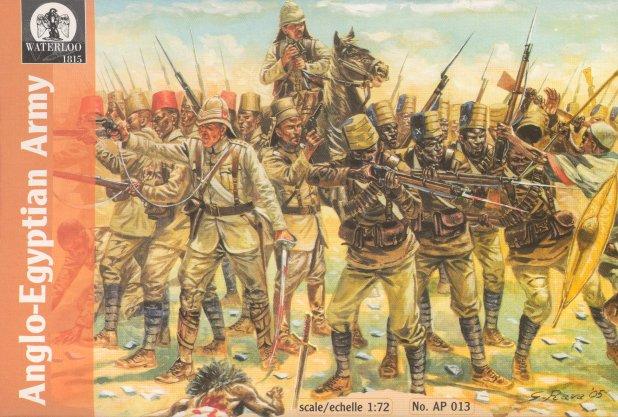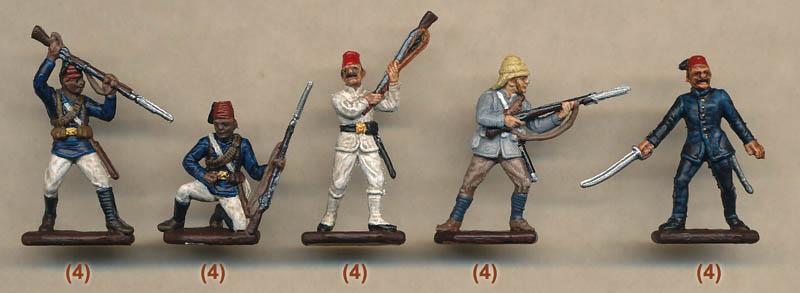Anglo-Egyptian Infantry, Sudan Campaign--48 figures in 12 poses & 4 horses in 1 pose UNPAINTED.
$12.00
Item Number: AP013
Anglo-Egyptian Infantry, Sudan Campaign
Date Released: 2005
Contents: 48 figures in 12 poses & 4 horses in 1 pose
Material: Plastic (Medium Consistency)
Color: light grey. UNPAINTED.
Average Height: 25 mm (= 1.8 m)
The 1880s were a time of great upheaval for the army of Egypt, as detailed in our review of the Dervish Infantry. They were taken over by the British, fought several largely unsuccessful actions in the Sudan, but succeeded in resisting an invasion from their southern neighbours. This turbulent decade provides the setting for these figures.
The majority of the men in this set are native Egyptian or Sudanese infantry. Prior to 1884 these troops wore a buttoned tunic and loose trousers tucked into gaiters, and a small fez called a tarboosh. In that year a new uniform was introduced of a jersey and trousers with puttees. Some of the native figures here wear the former uniform and some the latter, so the set covers the whole period, but generally the Sudanese troops wore the older uniform for longer. The last figure on the second row is an Egyptian officer, who correctly wears the popular single-breasted coat under which he has his sword belt, which would have made access to the weapon very difficult but was apparently common practice.
The other officers are British, with one on foot and the other mounted. They wear typical kit and are well done. Curiously just one other British man has also been included in the set - the fourth figure on the second row. He wears elements of standard uniform, and in particular has a bandolier round the trunk and puttees on the lower legs. He could be an infantryman, though more likely to be a cavalryman, including a member of the Camel Corps He could be used alongside the native troops, but we would have preferred another native infantryman in his stead.
The final figure is of General Charles 'Chinese' Gordon, the popular Victorian hero who died in 1885 at the siege of Khartoum. He is dressed in typical costume, making the figure largely useless for anyone else other than Gordon, which means having four such figures in a set is a waste. He carries a crocked stick (Gordon often carried a cane) and a revolver, but curiously the latter has been put in his left hand. Gordon was not left-handed, so we find it hard to understand why he was depicted this way as there are no images of him like this.
The sculpting of these figures is of the usual high standard for this company, with the style being similar to the Esci output. There is a noticeable amount of flash but this is better in some places than others. The poses are fine, with an emphasis on hand-to-hand fighting, although having fully one third of the figures representing officers and commanders seems excessive. We would like to have seen the officers on a separate sprue, allowing fewer of them to be in the set (particularly Gordon himself), and so making room for more infantry poses. That apart these are very nice figures, leaving the way clear for someone to make a full set of British infantry to represent the Wolseley expedition.



